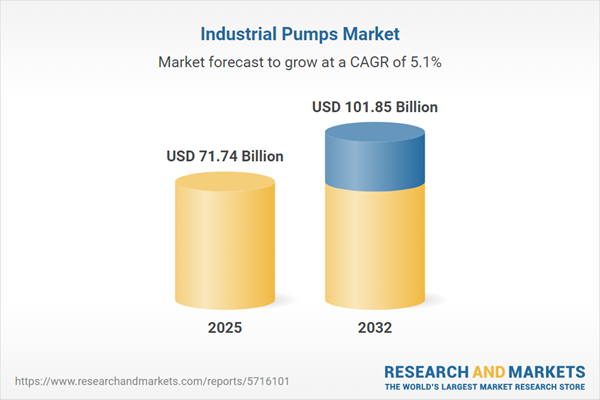Speak directly to the analyst to clarify any post sales queries you may have.
The industrial pumps market is entering a new phase, where reliability, sustainable practices, and advanced digital optimization guide business decisions and investment. Senior executives are now prioritizing fluid management strategies that respond rapidly to changing demands, operational complexity, and evolving compliance requirements.
Market Snapshot: Industrial Pumps Market Size and Growth Outlook
The industrial pumps market is projected to reach USD 101.85 billion by 2032, building on growth from USD 68.27 billion in 2024 and USD 71.74 billion in 2025. A compound annual growth rate of 5.12% demonstrates steady sector expansion, with consistent demand across manufacturing, energy, and water management applications. Market momentum stems from increased adoption of modern pump technologies, evolving materials science, and progressive integration of digital solutions. These factors are positioning manufacturers and stakeholders to better address reliability, compliance, and competitiveness across interconnected, global operations.
Scope & Segmentation: Dynamics Shaping the Industrial Pumps Market
- Pump Types: Centrifugal models—both single-stage and multi-stage—as well as reciprocating designs such as piston and plunger pumps, support a diverse range of industrial fluid movement, enabling organizations to align pump characteristics with specific process parameters.
- End User Industries: Chemical, petrochemical, food and beverage, mining, oil and gas, power generation, and water or wastewater management sectors each introduce distinct requirements for process safety and compliance, affecting pump selection and system design.
- Drive Types: Electric motors, diesel engines, or gas turbine drives facilitate flexibility in power sourcing and operational planning, supporting alignment with corporate sustainability targets and site-specific energy management.
- Orientation: Horizontal and vertical pump configurations offer adaptable installation options for both new infrastructure and the retrofit of existing sites, allowing for effective use of space and operational continuity.
- Geographic Regions: The Americas, Europe, Middle East and Africa, and Asia-Pacific each present unique regulatory frameworks, technology adoption timelines, and supply chain structures, shaping local investment priorities and innovation agendas.
- Key Companies: Grundfos Holding A/S, Xylem Inc., Sulzer Ltd., Flowserve Corporation, KSB SE & Co. KGaA, Atlas Copco AB, Ebara Corporation, The Weir Group PLC, SPX Flow, Inc., and IDEX Corporation are recognized for pioneering sector innovations and delivering robust service capabilities worldwide.
Strategic pump selection matched to process, facility, and geography allows organizations to meet compliance, integrate relevant technologies, and reduce investment risk amid an increasingly complex operating environment.
Key Takeaways for Strategic Planning
- Real-time monitoring and smart control systems enable precise oversight of pump operations, promoting higher uptime and responsive asset management across critical functions.
- Using pumps fabricated from modern materials can enhance durability and mitigate wear, supporting long-term sustainability objectives and lowering the total cost of ownership.
- Remote digital control platforms simplify scheduled and preventative maintenance, ensuring stable performance for distributed or multi-site installations with less frequent on-site checks.
- Partnering with international service providers helps unify maintenance practices and ensures systematic access to digital transformation expertise, strengthening post-installation asset support globally.
- Custom-engineered pumps tailored to meet specific regional or sector requirements minimize compliance risks and streamline routine operations in challenging regulatory landscapes.
- Flexible supply chain and sourcing practices allow quick adaptation to new technologies and emerging market requirements, shielding operations from potential disruptions or delays.
Tariff Impact: Navigating Trade and Supply Chain Adjustments
Shifts in United States tariff policy are prompting organizations to reconsider sourcing and production strategies within the industrial pumps market. Executives are mitigating risk by strengthening domestic manufacturing capacity, refining procurement processes, and leveraging advanced sourcing analytics to manage global volatility. Proactive scenario planning supports resilience in adapting to new trade landscapes while maintaining operational consistency across distribution and production networks.
Methodology & Data Sources
This market research draws from direct interviews with experienced professionals in engineering, maintenance, and procurement. Supplementary analysis of technical documentation, current regulations, and patent filings provides a comprehensive view of trends, supporting informed decision-making for executives seeking to benchmark best practices and policy developments.
Why This Report Matters for B2B Industrial Pumps Stakeholders
- Provides actionable insights for identifying growth opportunities and aligning strategic initiatives as regulatory environments and technologies evolve.
- Supports risk mitigation by offering recommendations on building supply chain resilience and compliance flexibility in dynamic markets.
- Enables forward-looking investment and competitive positioning through objective analysis of sector trends and emerging technologies.
Conclusion: Advancing Resilient Fluid Management
Comprehensive market analysis equips decision-makers to confidently manage operational complexity, champion digital transformation, and foster lasting value in industrial fluid systems management.
Additional Product Information:
- Purchase of this report includes 1 year online access with quarterly updates.
- This report can be updated on request. Please contact our Customer Experience team using the Ask a Question widget on our website.
Table of Contents
3. Executive Summary
4. Market Overview
7. Cumulative Impact of Artificial Intelligence 2025
Companies Mentioned
The companies profiled in this Industrial Pumps market report include:- Grundfos Holding A/S
- Xylem Inc.
- Sulzer Ltd.
- Flowserve Corporation
- KSB SE & Co. KGaA
- Atlas Copco AB
- Ebara Corporation
- The Weir Group PLC
- SPX Flow, Inc.
- IDEX Corporation
Table Information
| Report Attribute | Details |
|---|---|
| No. of Pages | 197 |
| Published | October 2025 |
| Forecast Period | 2025 - 2032 |
| Estimated Market Value ( USD | $ 71.74 Billion |
| Forecasted Market Value ( USD | $ 101.85 Billion |
| Compound Annual Growth Rate | 5.1% |
| Regions Covered | Global |
| No. of Companies Mentioned | 11 |









